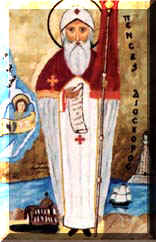
Anthemius of Tralles was a Greek from Tralles who worked as a geometer and architect in Constantinople, the capital of the Byzantine Empire. With Isidore of Miletus, he designed the Hagia Sophia for Justinian I.

The Council of Chalcedon was a church council held from 8 October to 1 November, 451, at Chalcedon, a town of Bithynia in Asia Minor. The Council was called by Emperor Marcian to set aside the 449 Second Council of Ephesus. Its principal purpose was to assert the orthodox catholic doctrine against the heresy of Monophysitism and Eutyches, although ecclesiastical discipline and jurisdiction also occupied the council's attention.

Pope Boniface II was the first Germanic bishop of Rome. He ruled the Holy See from 22 September 530 until his death. He was born an Ostrogoth.
Eutyches was a presbyter and archimandrite at Constantinople. He first came to notice in 431 at the First Council of Ephesus, for his vehement opposition to the teachings of Nestorius; his condemnation of Nestorianism as heresy led him to an equally extreme, although opposite view, which precipitated his being denounced as a heretic himself.

Anatolius was a Patriarch of Constantinople. He is regarded as a saint, by both the Orthodox and Roman Catholic Churches.

Dioscorus I was the pope of Alexandria and patriarch of the See of St. Mark who was deposed by the Council of Chalcedon in 451. He was recognized as patriarch by the Coptic Church until his death. He died on the island of Gangra, Paphlagonia, in September 454. He is venerated as a saint by the Coptic and other Oriental Orthodox churches.
Dioscorus was a deacon of the Alexandrian and the Roman church from 506. In a disputed election following the death of Pope Felix IV, the majority of electors picked him to be pope, in spite of Pope Felix's wishes that Boniface II should succeed him. However, Dioscorus died less than a month after the election, allowing Boniface to be consecrated pope and Dioscorus to be branded an antipope.
Hieromartyr Proterius of Alexandria was Patriarch of Alexandria from 451 to 457. He had been appointed by the Council of Chalcedon to replace the deposed Dioscorus.
The Second Council of Ephesus was a Christological church synod in 449 AD convened by Emperor Theodosius II under the presidency of Pope Dioscorus I of Alexandria. It was intended to be an ecumenical council, and it is accepted as such by the miaphysite churches but was rejected by the Chalcedonian dyophysites. It was explicitly repudiated by the next council, the Council of Chalcedon of 451, recognised as the fourth ecumenical council by Chalcedonian Christians, and it was named the Latrocinium or "Robber Council" by Pope Leo I. The Chalcedonian churches, particularly the Roman Catholic and Eastern Orthodox communions, continue to accept this designation, while the Oriental Orthodox repudiate it.
Pope Dioscorus may refer to:
Flavius Dioscorus lived during the 6th century AD in the village of Aphrodito, Egypt, and therefore is called by modern scholars Dioscorus of Aphrodito. Although he was an Egyptian, he composed poetry in Greek, the cultural language of the Byzantine Era. The manuscripts, which contain his corrections and revisions, were discovered on papyrus in 1905, and are now held in museums and libraries around the world. Dioscorus was also occupied in legal work, and legal documents and drafts involving him, his family, Aphroditans, and others were discovered along with his poetry. As an administrator of the village of Aphrodito, he composed petitions on behalf of its citizens, which are unique for their poetic and religious qualities. Dioscorus was a Christian and lived in a religiously active environment. The collection of Greek and Coptic papyri associated with Dioscorus and Aphrodito is one of the most important finds in the history of papyrology and has shed considerable light on the law and society of Byzantine Egypt.
Protogamasellopsis is a genus of mites in the family Rhodacaridae.
Protogamasellopsis corticalis is a species of mite in the family Rhodacaridae.
Protogamasellopsis posnaniensis is a species of mite in the family Rhodacaridae.
Pope Dioscorus II of Alexandria, 31st Pope of Alexandria & Patriarch of the See of St. Mark. He was chosen Patriarch after the departure of his predecessor, St. John. His first work after his enthronement to the See of St. Mark was writing an epistle to Pope Severus, Patriarch of Antioch concerning the Holy Trinity and the Incarnation. Pope Dioscorus had Severus's reply read from the pulpit.
Papyrus Oxyrhynchus 52 is a report from two public physicians, written in Greek. The manuscript was written on papyrus in the form of a sheet. It was discovered by Grenfell and Hunt in 1897 in Oxyrhynchus. The document was written between 25 July and 23 August of the year 325. It is housed in the Glasgow University Library. The text was published by Grenfell and Hunt in 1898.
Papyrus Oxyrhynchus 102 is a lease of land, written in Greek and discovered in Oxyrhynchus. The manuscript was written on papyrus in the form of a sheet. The document was written 13 October 306. Currently it is housed in the British Museum (766) in London.
In the letters to the early Christian churches of Smyrna and Philadelphia in Revelation 2:9 and 3:9, reference is made to a synagogue of Satan, in each case referring to a group persecuting the church "who say they are Jews and are not".




